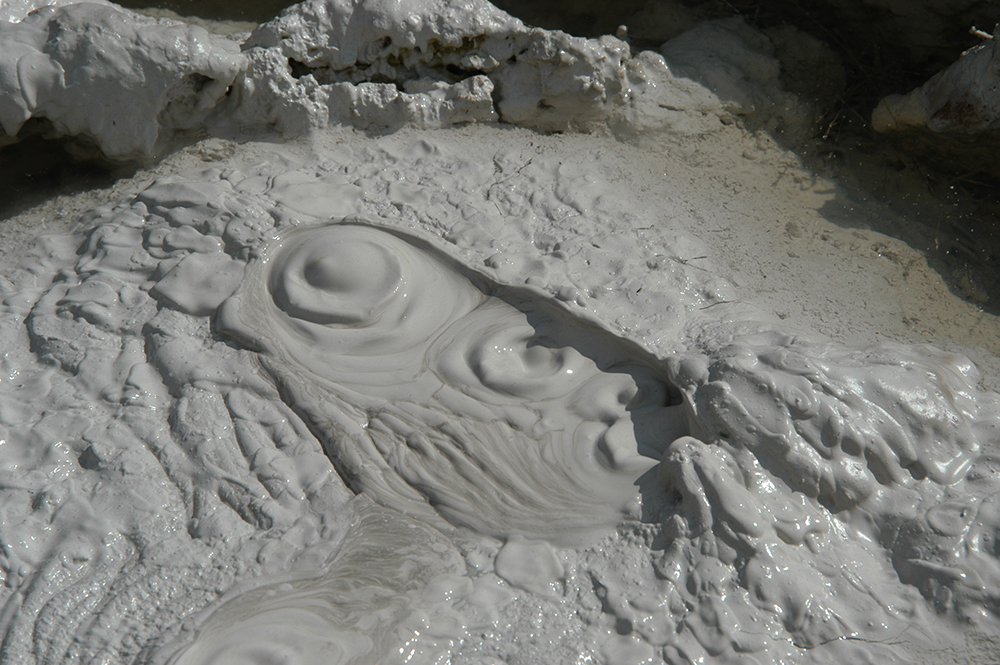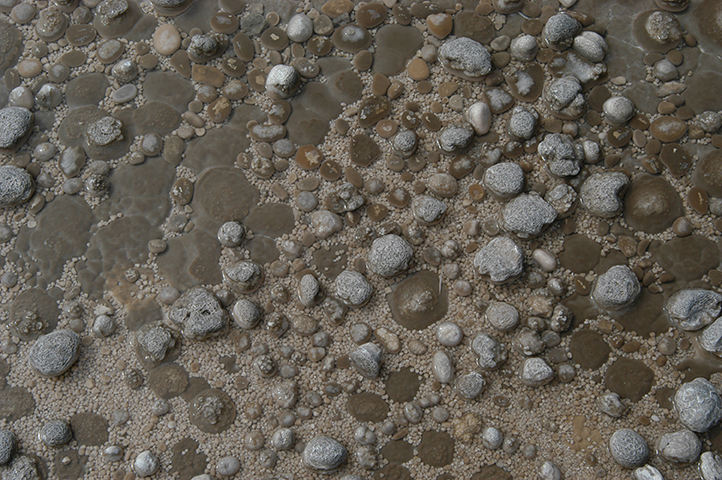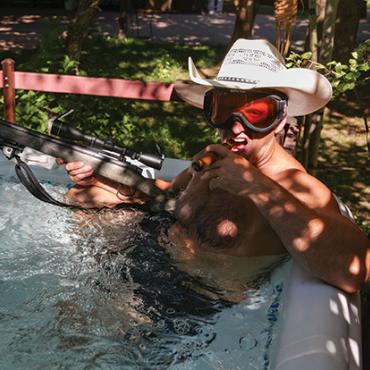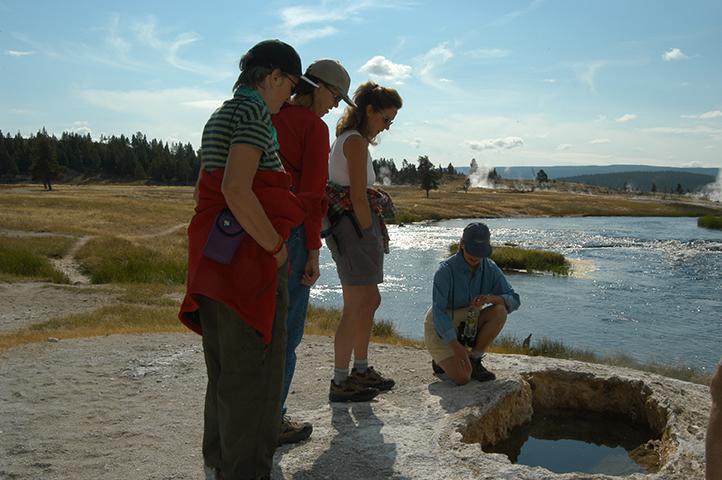Thermal Theater
Learning about Yellowstone's thermal features.
Peering into the surging, superheated water of Ojo Caliente, the rising steam brings an acrid, sulfurous stench to our nostrils. We grimace in unison. The intensely alkaline water looks as inhospitable as it smells—this is no place for an impromptu hot-tubbing session. But as bleak and sterile as the steaming pool appears, explains Linda Wallace, our Yellowstone Country Adventures guide for the day, it’s home to thousands of microorganisms called “thermophiles.” Not only can they withstand the scalding water and seemingly barren environment, she tells us, but they’re highly prized by scientists and researchers. These hot-water denizens have been used in the breakdown of toxic oil and paint, the conversion of corn to ethanol, and the removal of sulfur from coal. An enzyme from one particular thermophile, Thermus aquaticus, allowed the development of our most accurate HIV test and the forensic application of DNA fingerprinting.
Such are the lesser-known wonders of Yellowstone National Park—remarkable natural phenomena hidden in the most unlikely places, the most enigmatic environs. And with Linda guiding us, we’re sure to hear about them all. Spry and cheerful at 57, she’s got a hiker’s legs and lungs, a schoolteacher’s patience, and the accumulated knowledge that comes from over three decades spent exploring Yellowstone’s inimitable natural environment. Today’s setting—and one of her all-time favorite spots—is the Lower Geyser Basin, 12 square miles of steaming hot springs, spouting geysers, bubbling mud pots, and hissing fumaroles. It’s the largest of the Park’s 12 major geyser basins, and according to her, the most interesting. “The Lower Basin has a little bit of everything,” she says, “colorful geyser cones, explosive eruptions, huge pools of simmering mud. And many of them are a ways off the road, so you’ll often have them to yourself.”
That’s certainly the case right now. As we make our way down a broken game trail, our only company is an osprey circling overhead and a few mountain bluebirds flitting around the trees on our left. To our right meanders the Firehole River, its indigo water warmed by the hundreds of hot springs flowing into it. Weaving in and out of the ubiquitous hot springs, we watch our steps carefully—a trip-up and subsequent plunge into one of these 200-degree pools would mean certain death. Still audible are the muffled thunder-claps of bubbles bursting in a cavernous mud pot we’d passed a half-mile back.

Our group is an eclectic one—an antique store owner from Bozeman; a local designer and entrepreneur; a senior staff member of the Greater Yellowstone Coalition, a photographer from Livingston, Linda, and myself. Our conversations are diverse and lively. Equally fascinated by the striking thermal features and Linda’s lively naturalist commentary, we strike an immediate rapport. During an extended stop at a particularly effervescent spring, the designer leans toward me. “I love going to the park with Linda,” she says in a half-whisper, like it’s a secret reluctantly revealed. “She always takes me to places I’d never find on my own.”
We leave the river near Pocket Basin, where, as Linda tells us, a hydrothermal explosion blew out an ancient lake long ago. It’s now a sprawling flat peppered with thermal features. As we cross the old lakebed, Linda explains how a series of underground channels—“earth’s plumbing”, she calls it—profoundly affects the landscape we’re traversing. During the earthquake of 1959 (the one that formed Quake Lake), subterranean thermal activity shifted up the far side of the lakebed. A graveyard of charred tree trunks on the facing slope gives compelling testimony: their roots scorched by the boiling water, the lifeless trees now form a “thermal burn.”
Climbing out of the flat, we cross a high plain scattered with small groves of lodgepole pine. Linda leads us into a copse off to the right, and as the trees clear we find ourselves at the edge of a wide sink, where massive mud pots sputter and splash. A creamy taupe color, they look like boiling drywall mud. Mud stalagmites rise all around, formed by the accumulated deposits of repeated bubble-bursts. We gather around a large pool and stare, entranced by its slow, rhythmic pulsating. It’s tempting to dip a finger in, or even thrust an entire hand into the seething brown mass, just to see what it feels like—but the sweltering steam gives us pause. Best to leave it to the imagination.

After a discussion of “thermal feature habitat” (as with animals, Linda explains, characteristics within the landscape itself can hold clues as to the presence of thermal features), we leisurely retrace our steps and load the cars. Our next stop is a shorter excursion: a drive by Pink Cone, the shell-pink sinter cone that erupts with a steady, 30-foot column of water which tapers off and resurges, over and over. This dramatic cycle makes Pink Cone a favorite among geyser aficionados. A quick hike into the impressive but unpredictable Narcissus Geyser (despite a predicted eruption, it remained calm the entire 40 minutes we were there), a leisurely lunch in the shade of lodgepoles and Douglas fir, and then back to the cars for the last leg of the trip. The late lunch and warm afternoon sun have slowed us all down a bit, but Linda’s enduring enthusiasm infects the group, and we’re more than ready for the day’s last round of thermal features.
No Yellowstone thermal exploration would be complete without a visit to Grand Prismatic Spring—and no amount of visits can diminish the awe it inspires. We pull the cars over and take a quick jaunt through “Hell’s Half-Acre,” a small swath of gigantic springs situated between the Lower and Upper Geyser Basins. Interesting enough from the boardwalk, the Grand Prismatic is another experience entirely from the hillside above. We make the 10-minute hike and are rewarded with a breathtaking view: brilliant iridescence radiates from the 400-foot-wide lake of fire. The thermophiles are abundant here; in fact, they explain the spring’s brilliant coloration. Spread around the spring in “microbial mats,” the reddish, less heat-resistant bacteria inhabit the outer edge of the pool, while yellowish and greenish bacteria dominate the progressively hotter water closer to the middle. The center of the pool is too hot for even the hardiest thermophiles, and so remains a deep and beautiful blue. The combined effect is a sort of circular rainbow; so vast and brilliant that everything else seems drab in comparison. It’s no wonder that the Grand Prismatic Spring has drawn artists, photographers, and poets to its variegated water for generations.
We continue up the trail, making our way back into the Lower Basin. After a water break at the crashing, 200-foot-tall Fairy Falls (I take the rare opportunity for a quick swim—cold as glacier-melt but refreshing), we move on, and soon find ourselves marveling at the aptly-named Spray Geyser, where a tumultuous, near-constant surging is interrupted by intermittent blasts of water 25 feet into the air. It’s quite a sight—nature’s version of a fireworks show, perhaps—and we can’t help but wonder what strange and powerful forces are at work down there, miles beneath the gurgling, steaming forest floor.
At the end of the trail is Imperial Geyser, an 80-foot shooter surrounded by a steaming network of interconnected pools. A stream of silica-laden water—500-gallons-per-minute—tumbles down the grassy slope below. Fallen tree branches, saturated with silica, look bizarre and otherworldly, like soggy petrified wood. Long-dead, gnarled tree stumps, stark white at the base from the seeping silica, jut out of the ground all around us. Staring at the two-toned trees ("bobby-socks," she calls them), we marvel at how the silica both kills and preserves these luckless arboreal inhabitants, and how even in death, they add beauty and diversity to the landscape. It’s an odd dichotomy, this silica-infused forest, a strange combination of sterility and fecundity. As strange as the thermophiles, or the gurgling steam holes, or any of the hundreds of sights and sounds utterly unique to this geothermic wonderland.
But then again, this is Yellowstone Park, the place that captured the imaginations of our earliest scientists and explorers and moved them to plead for its preservation—at the time, an unprecedented idea. But preserve it Congress did, and so its amazing, incomparable thermal features continue to puzzle and inspire visitors like us—day after day, year after year.
To book a trip with Yellowstone Country Adventures, call Linda Wallace at 581-7476 or email [email protected]







